As Defenders of Wildlife’s Senior Representative in Northwest Florida my work focuses on protecting habitat for at-risk wildlife such as sea turtles, gopher tortoises, manatees, red-cockaded woodpeckers and the Florida panther. Typically, my work involves advocacy, public outreach and education. I don’t often get to experience, first-hand, the wildlife I’ve dedicated my career to protecting …. so you can imagine how exciting it was to have the opportunity to film a live gopher tortoise (and gopher frog!) rescue as part of Wildlife Nation.
Gopher tortoises (Gopherus polyphemus) live in the dry, sandy uplands of the southeastern United States with the largest remaining populations being in Florida and Southwestern Georgia. These animals are a keystone species and play a vital role in their natural habitats. They dig long, deep burrows (up to 40 feet in length and fifteen feet deep!) in which they spend most of their time when not out foraging for the large variety of plants they feast on. These extensive burrows help tortoises escape extreme temperatures and predators. And even better – tortoises don’t mind sharing. Over 350 other species use these burrows too, including the Florida mouse, burrowing owl, gopher frog and the threatened eastern indigo snake. Without gopher tortoises and their burrows, many of these commensal species would vanish.
Unfortunately, due to human interference, gopher tortoises no longer inhabit a large area of their historic range. Though protected to various degrees by states and the U.S. Fish and Wildlife Service, gopher tortoises are increasingly threatened by habitat loss, roadkill, predation and climate change, and continue to be illegally harvested by people. While Defenders is working to reverse this habitat loss and population decline through large-scale land conservation efforts, Defenders’ partners (like Saving Florida’s Gopher Tortoises) lead efforts to relocate gopher tortoise colonies being impacted by active development projects.
The rescue!
Rescuing gopher tortoises from the developer’s bulldozer was not an easy process. Before Jeff Corwin could film this episode of Wildlife Nation in the “sauna of Central Florida,” our partner Carissa Kent with Saving Florida’s Gopher Tortoises made the necessary arrangements. Carissa made sure the rescued animals were safely excavated and transported to protected habitat on Nokuse Plantation in Northwest Florida. Carissa’s organization has rescued thousands of gopher tortoises and has the process down to an art, taking care to not harm gopher tortoises and their commensal species as they excavate the burrows.
It was an outstanding moment in my career to be there with Jeff and Carissa to show how gopher tortoises are safely rescued from development. That’s an experience I won’t forget and – hopefully – if you’re watching it for the first time, it inspires your curiosity about gopher tortoises and other imperiled wildlife here in Florida, and across North America.
Protecting a species
While relocation does save some tortoises, Defenders also works to protect the species in their home habitat. We advocate for responsible development and protection of additional public lands, and we work with landowners to establish conservation easements that protect the animals even on private land.
I serve on the state’s Gopher Tortoise Technical Assistance Group supporting science-based updates to the state’s Gopher Tortoise Management Plan and the guidelines for development in tortoise habitat. We also work with agencies and private land managers like foresters and farmers on Wildlife Best Management Practices, guiding operations on private forests and agricultural lands to protect gopher tortoises, their nests and burrows.
How can you help?
Not everyone will meet a gopher tortoise in their lifetime, but there are things that you can do to help gopher tortoises, whether you live in Florida or are just visiting. For one thing, please always watch out for wildlife when driving in Florida. Tortoises, like many forms of wildlife, can be killed when crossing roads. And since they move more slowly, they’re especially vulnerable. If you spot a tortoise in the road and want to help, please do so carefully – don’t put your own life in danger! If it’s safe, you can help the tortoise cross the road by placing it out of harm’s way in the same direction that it was going. But do not take it with you or move it to a different area – not only can that be bad for the tortoise, but it’s against the law. And please don’t ever put the animal in water, they are a terrestrial species. You can also report sightings to the Florida Fish and Wildlife Conservation Commission via their the free FWC Reporter app from the App Store and Google Play.
You can also share fun gopher tortoise facts with your friends and family – check out a few of my favorites here. My hope is that shows like Wildlife Nation, and organizations like Defenders of Wildlife and Saving Florida’s Gopher Tortoises will cultivate a love and respect for wildlife that will ensure the next generation of wildlife advocates.











Follow Defenders of Wildlife
facebook bluesky twitter instagram youtube tiktok threads linkedin